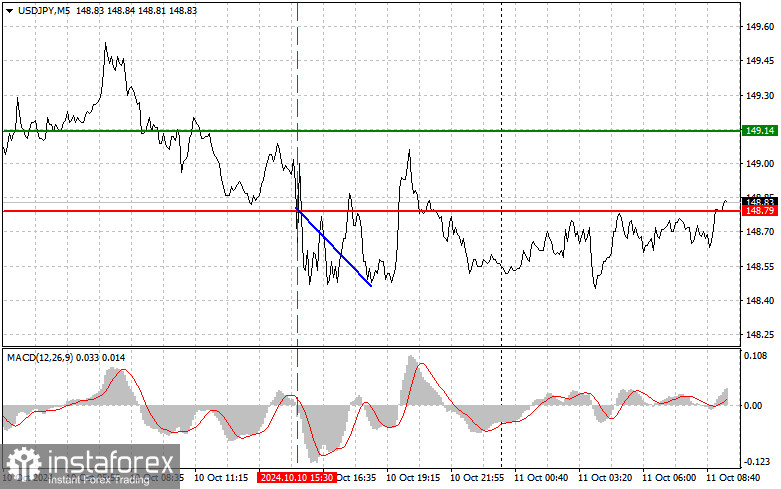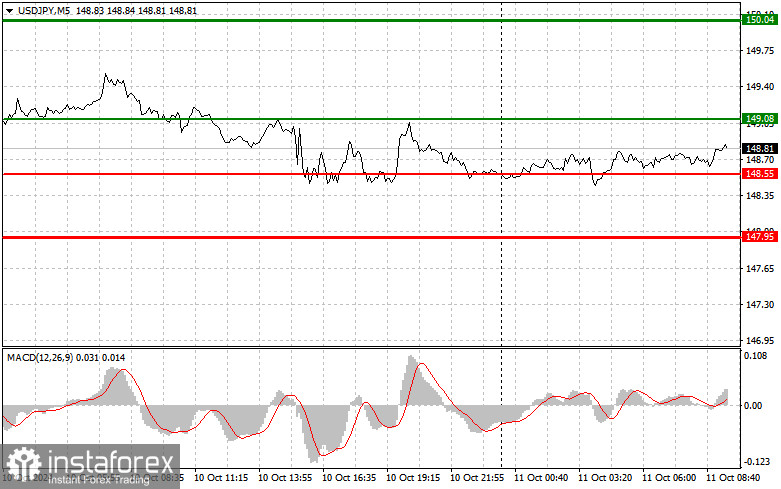Analysis of Trades and Tips for Trading the Japanese Yen
The test of the 148.79 price level occurred when the MACD indicator began moving down from the zero line. This confirmed the appropriate entry point for selling the dollar. As a result, the pair dropped by 30 points, and the movement halted there. The target level was not reached. Despite rising inflation in the U.S., USD/JPY remained trading within the sideways channel, where it has been for most of the week. It is unlikely that we will break out of this range today, so I plan to trade within it. Data on Japan's money supply change did not alter market sentiment, nor was it expected to. The focus now shifts to the upcoming U.S. inflation data, which will be analyzed in detail in the forecast for the second half of the day. For intraday strategy, I will primarily focus on implementing scenarios #1 and #2.

Buy Signal
Scenario #1: Today, I plan to buy USD/JPY at the entry point around 149.08 (green line on the chart), targeting a rise to 150.04 (thicker green line on the chart). Around 150.04, I plan to exit buy trades and open sell trades in the opposite direction, expecting a movement of 30-35 points in the opposite direction from this level. A strong rise in the pair is, however, unlikely today. Important: Before buying, ensure that the MACD indicator is above the zero line and just starting to rise.
Scenario #2: I also plan to buy USD/JPY today in case of two consecutive tests of the 148.55 price level when the MACD indicator shows an oversold signal. This will limit the pair's downward potential and lead to a market reversal upward. A rise to the opposite levels of 149.08 and 150.04 can be expected.
Sell Signal
Scenario #1: I plan to sell USD/JPY today only after a breakout below the 148.55 level (red line on the chart), which will lead to a quick drop in the pair. The key target for sellers will be 147.95, where I plan to exit the sell trades and immediately open buy trades in the opposite direction, expecting a movement of 20-25 points in the opposite direction from this level. Pressure on the pair will return if the pair fails to maintain gains near the daily high. Important: Before selling, ensure that the MACD indicator is below the zero line and just starting to fall.
Scenario #2: I also plan to sell USD/JPY today in case of two consecutive tests of the 149.08 price level when the MACD indicator indicates an overbought condition. This will limit the pair's upward potential and lead to a market reversal downward. A drop to the opposite levels of 148.55 and 147.95 can be expected.

What's on the Chart:
- Thin green line – entry price for buying the trading instrument.
- Thick green line – suggested price for setting Take Profit or manually locking in profits, as further growth above this level is unlikely.
- Thin red line – entry price for selling the trading instrument.
- Thick red line – suggested price for setting Take Profit or manually locking in profits, as further decline below this level is unlikely.
- MACD Indicator: It is important to use the overbought and oversold zones as guidance when entering the market.
Important: Beginner forex traders should be very cautious when making entry decisions. It is best to stay out of the market before the release of important fundamental reports to avoid sudden price swings. If you decide to trade during news releases, always set stop-loss orders to minimize losses. Without stop-loss orders, you could quickly lose your entire deposit, especially if you don't use proper money management and trade large volumes.
Remember, for successful trading, a clear trading plan is essential, such as the one presented above. Spontaneous trading decisions based on the current market situation are inherently a losing strategy for an intraday trader.





















